| |
Wildflecken Training Area (WTA)
Located 35 kilometers northwest of Bad
Kissingen, Wildflecken Training Area seemed a second home for the
Eaglehorse in the 1970's and early 80's. In a twist of history, it did
become the home to the squadron in 1991. We were at this place long
and often; vast fields of mud in Area H, hill 808, the micro climate
of the area that allowed snow, rain and sun and fog at the same time
and exchanging the German operator of the down range moving target at
midnight are some lasting impressions of those times.
| |
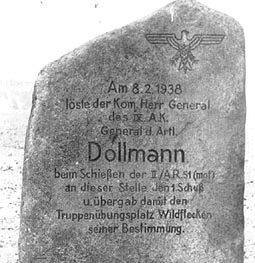 |
|
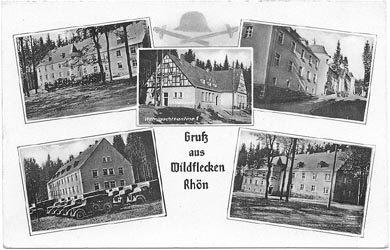 |
|
| |
This stone marker
remembers the firing of the first round by the German Army at
Wildflecken. The marker was located by one of the firing points used
by the US Army decades later.
Burckhardt |
|
World War 2 era
German post card of Wildflecken Kaserne.
Stefanowicz |
|
Early History of WTA
The creation of Wildflecken Kaserne
dates to the same wave of military expansion that built Manteuffel
Kaserne. The planning and acquisition of 18,000 acres began in
1936. The area was viewed as an ideal site to support training for
"low mountain" warfare. Eight small towns and villages were emptied
in site preparation. A large work force was brought to the area and
working in three shifts, rapidly built a military base planned to
support a troop population of 9, 000 men. An ammunition plant was also
built on adjacent land. Ranges and maneuver space were built to make
Wildflecken a 'second level' military training area. On 8 February
1938, General Dollmann, Commander of the IX German Corps and Inspector
of Artillery units fired the first round down range and Wildflecken
Training Area was inaugurated.
| |
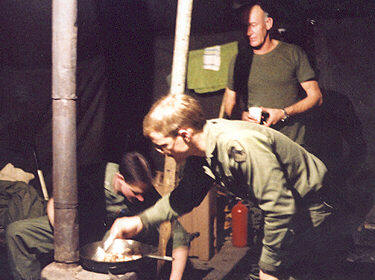 |
|
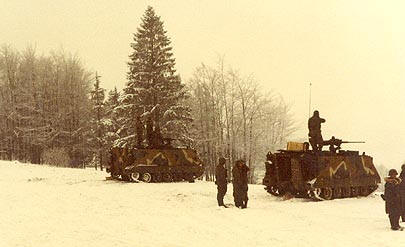 |
|
| |
Tent life at Area H;
inside a GP medium tent, LT Sommerkamp, center, and First Sergeant
Cameron, right, chase down a snack heated up on a coal burning
stove.
Stefanowicz |
|
G Troop scouts on
firing line at WTA, 81. The target array down range consisted of non
mobile target forms. As of this period, the Saab target system only
supported the tank ranges.
Stefanowicz |
|
During the late 1930's and war years, a
wide variety of units passed through Wildflecken Kaserne. It served as
a training hub for SS units, notably the 5th SS Panzer Division
"Viking" and the 33rd SS Infantry Division "Charlemagne" [French
volunteers] as well as Heer divisions, 95, 82 and 345 among others.
The ammunition plant was staffed with forced labor imported from the
East. As the war ended in 1945, there was no significant fighting at
Wildflecken as American units swept through.
Of note, General Dollmann,
who officiated at the opening of the military complex did not survive
the war. As Commander of the 7th German Army in France in 1944, he
faced the Allies in the initial days of the invasion. As German units
were rolled back early that Summer, Hitler reprimanded and threatened
his field commanders. The circumstances of Dollmann's death are
clouded between heart failure and suicide in the field during this
period. He was replaced by General Paul Hauser.
| |
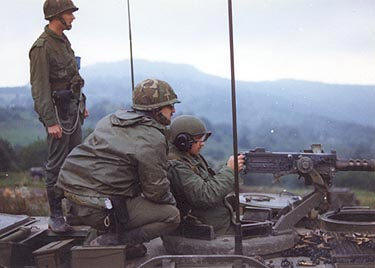 |
|
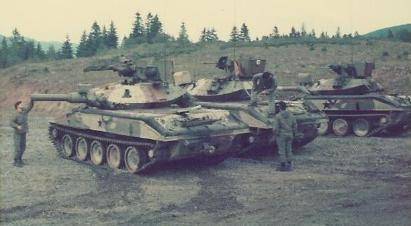 |
|
| |
Scout live fire
training at WTA. CPT Campbell, center, coaches SP/4 Dedge with M2
flex. SP/4 MacClendon observes.
Stefanowicz |
|
M551 Sheridans on the
range at Wildflecken in the mid-1970s
Mowry |
|
The Refugees Arrive, the
American Stay, the Bundeswehr Leaves
During the same post war period that
Daley Barracks was the European Central Office for the International
Refugee Organization, Wildflecken Kaserne was one of the large
collection points for displace persons. Many refugees who found their
way to the United States find "Lager (Camp) Wildflecken" stamped on
their first official documents.
In 1951, the business of the IRO ended
and the American Army re - activated Wildflecken as an active base and
training area. It was then in continuous use in that capacity by the
NATO allies until 1994. In 1967, Wildflecken was incorporated into the
7th Army Training Center Command. Through this period, a wide variety
of US Army armor, infantry, engineer and air defense units called
Wildflecken home. For V Corp units, this became one of the major
training areas.
| |
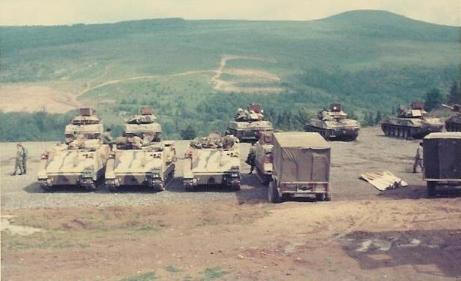 |
|
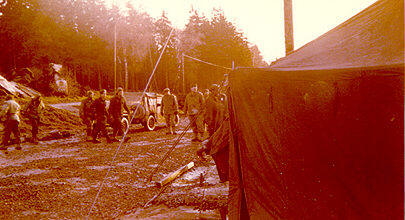 |
|
| |
M551 Sheridans on the
range at Wildflecken in the mid-1970s
Mowry |
|
Tent City in
Wildflecken circa 1981
Cozzens |
|
Hill 808, the dominant terrain feature
down range and Area H, the concrete pad and GP medium area we occupied
while training are well remembered. In conjunction with M1 and M3
fielding in USAREUR, the ranges and support areas of Wildflecken
received a major upgrade. By the mid 1980's, the tents were gone,
replaced with permanent barracks buildings similar to facilities found
at Grafenwoehr. More realistic firing ranges supported the new
generation of fighting vehicles. Norbert Ruckel provided a
number of shots of
Wildflecken during the years 1984-1992.
The Eaglehorse squadron called
Wildflecken home for a few years after the squadron departed Daley
Barracks. It was the last major Army unit assigned to Wildflecken.
The post then became home to a variety of Bundeswehr units and a
Computer Battle Simulator Center. In recent years, as Germany has
drawn down force size, the number of active units at Wildflecken has
decreased. It is at about 30% of troop carrying capacity and the
future of the Kaserne is under active consideration.
What Was Left Behind
Norbert Ruckel recently took a trip to
Wildflecken and visited the German run on-post museum. It tells the story of the training area from
1936 with a sizable portion devoted to the American years. Unit
signs, photos and plaques make up much of that part of the display.
Interestingly, the Eaglehorse must have taken everything with them
when they finally departed, there is no reference to the squadron.
|
|